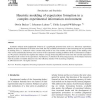Free Online Productivity Tools
i2Speak
i2Symbol
i2OCR
iTex2Img
iWeb2Print
iWeb2Shot
i2Type
iPdf2Split
iPdf2Merge
i2Bopomofo
i2Arabic
i2Style
i2Image
i2PDF
iLatex2Rtf
Sci2ools
EOR
2007
2007
Heuristic modeling of expectation formation in a complex experimental information environment
Academic subjects made judgmental forecasts of a graphically presented time series in a laboratory experiment. Besides the past realizations of the time series itself, the only available information for the forecasting task was provided by leading series, i.e. indicators with a constant lead period of one. The number and the quality of the leading series were varied systematically between seven versions of the experiment resulting in different levels of information complexity. We present a heuristic that explains the subjectsÕ average forecasting behavior better than the rational expectations hypothesis in all versions of the experiment. Furthermore, we find that the forecasting accuracy of the subjects increases with the number of reliable indicators but their efficiency declines with increasing complexity. Ó 2005 Elsevier B.V. All rights reserved.
Related Content
| Added | 13 Dec 2010 |
| Updated | 13 Dec 2010 |
| Type | Journal |
| Year | 2007 |
| Where | EOR |
| Authors | Otwin Becker, Johannes Leitner, Ulrike Leopold-Wildburger |
Comments (0)

